Abstract
Urbanization is closely connected to the migration of the rural population in Siberia; it played a significant role in the development and growth of cities. The article is devoted to the study of the social demographic portrait of rural migrants of Turkic peoples of Siberia (the Khakass). It is noted that migrants in their composition are not homogeneous mass, but differ in sex and age, marital status, size of families, financial position, housing conditions and in family income. The aim of the study is to characterize the social demographic portrait of a modern Turkic rural migrant. The empirical base is compiled by materials of a sociological survey using a patterned interview method. The main research question is related to finding out the most common “type” of a modern rural migrant. The article is based on social survey materials conducted with the support by RFBR according to the research project No. 18-39-00074 mol_a). The sample was targeted (N=1000): former villagers (an equal number of Russians and Khakass). The sampling error was no more than 5%. The following conclusions were made during the study. The portrait of a modern migrant in comparison with mid 2000s has changed: non-resident Khakass are mostly employable population with a secondary level of education, engaged in the fields of physical labor. Although the general financial situation of the Khakass has improved, the problem of their own housing remains acute, which may turn out to be a stumbling-block to their integration into the urban environment.
Keywords: Migrationrural migrantsTurkic peoplesKhakass
Introduction
The development of urbanization processes is closely related to the intensity of migration flows. According to researchers, it is the work force of the rural population that fills the labor shortage of urban centers (Ishtiaque & Ullah, 2013). Studies of rural migration causes in developing countries (India, Latin America, China and Africa) prove that the motives for rural people to move to cities are due to various factors. Personal motives associated with education or marriage (Khan, Hassan, & Shamshad, 2011), environmental causes, natural disasters in particular, forcing people to leave the countryside (Bilsborrow, 2011), hard working conditions (Shi, 2008) and even human rights violations (xenophobia) (Mosselson, 2010) are among them. The rural population migration is mainly related to economic reasons in Russia: lack of work, low living standard, degradation of rural areas. However, it cannot be considered that the entire rural population is inclined to migration because of the crisis in rural areas: there are other reasons that cause the transfer of the rural population to cities (environmental degradation, ethnic tensions) (Lushnikova, 2018). Represented by Kliuev (2015), migrants are differentiated by the level of education, professional training; they are the representatives of different social demographic, ethnic and confessional groups. In other words, migrants are not a homogeneous community, but differ in gender and age characteristics, social status, marital status, migration motives, etc.
Problem Statement
Urbanization processes proceeded fairly quickly in Turkic peoples of Siberia (including the Khakass) (Tinikova, 2018). According to All-Union Population Census in 1926, the bulk of the population was concentrated in rural areas, with only about 6% of the population living in cities. However, the intensive development of industry has turned Khakassia from an agricultural region into a rapidly developing industrial region with a predominance of urban population in less than 100 years. The growth of the urban population occurred both at the expense of inter-regional and intra-regional migration. Conventionally, several waves of migration flows that have replenished the urban population of Khakassia can be singled out. The first wave is connected with the beginning of industrialization, the active development of industry: the urban population increased by more than 100 thousand people during this period (1926-1939). The second wave occurred in war years, when population growth was due to evacuees from different regions of the country. The third wave (1959-1979) is associated with the development of virgin and fallow lands: the urban population increased by almost 40 thousand people during this period. Although the majority of the arriving population has filled up the rural population, it can be assumed that some of them, being unable to adapt to difficult conditions of virgin lands, migrated to Khakassia cities, because the rural population decreased during that period. The fourth wave (the beginning of the 1970s), which replenished the urban population, mainly occurred at the expense of internal migration of the rural population to cities, which was associated with the development of Sayan Territorial Production Complex (TPC) and the construction of large industrial facilities (Sayano-Shushenskaya HPS, Sayan aluminum plant, the enterprise “Abakanvagonmash”). The urban population increased by 146 thousand people and amounted up to 72.5% of total population of Khakassia during this period (1970-1989). The fifth wave began in the 1990s, when massive closure of large industrial enterprises began in rural areas, which initiated a massive outflow of villagers to the city in search of work. About 26 thousand people migrated to urban settlements over a period of 1991-2010.
The analysis of the national composition of rural migrants over a period of 2001-2007 showed that the indigenous population of the republic, the Khakass (about 12% of total population of the region), in comparison with the Russians (80% of the population) were less mobile in movements (Fig. 1). If a migration increase among Russians was recorded in urban areas, then among Khakass, on the contrary, migration decrease (Rosstat Abakan, 2012).
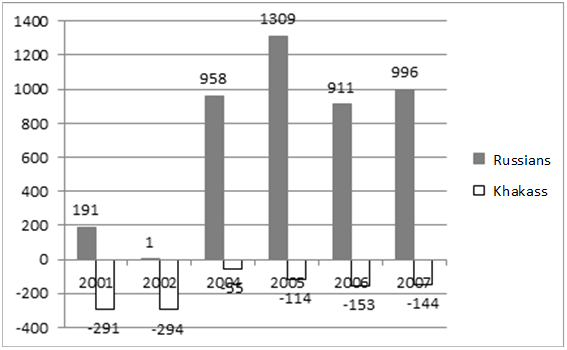
The Khakass compared to other peoples living in the territory of Khakassia, are least urbanized. Only a third of the Khakass (38.4%) live in urban settlements, while the share of urban Russians is 71.1% (Rosstat, 2012). Such statistic data suggest that adaptation to urban conditions among indigenous peoples (the Khakass, in particular) is difficult, which forces them to return to the village.
Research Questions
The main research question is related to the identification of the most common “type” of a modern rural migrant of one of the Turkic peoples of Siberia (the Khakass), depending on gender, age, marital status, level of education. The characteristic of migrants is of particular interest as the work force of the urban community (type and sphere of activity, length of service, nature of labor), as well as their living conditions (housing conditions, average monthly income, financial position).
Purpose of the Study
The aim of the study is to characterize the social demographic portrait of a modern rural migrant of Turkic peoples (evidence from the Khakas).
Research Methods
The empirical base is compiled by materials of a sociological survey conducted with the support by RFBR according to the research project No. 18-39-00074 mol_a). A survey using a patterned interview method was conducted in urban settlements of Khakassia (N=1000). The sample was targeted: former villagers were surveyed (an equal number of Russians and Khakass); the quota sample method was applied to the target group (by sex and age). The ratios of groups in the sample are close to their ratio in the general population. The sampling error was no more than 5%. Data processing was performed using statistical data application package of IBM SPSS Statistics 19.
Findings
According to the survey results, two thirds of the migrating rural population of Khakassia is an economically active and employable population between the ages of 25 and 55. The young population (18-24) and people of pre-retirement age (over 55 years old) comprise about a third of the surveyed migrants (Table
It seems to be difficult to single out the most common “type” of a rural migrant analyzing the obtained data; rather, we can speak of the predominance of the two largest social demographic groups. The first group comprises young men (25-34) with secondary specialized education, married and having two children. The second group consists of married women of mature age (45-54) with secondary specialized or higher education, having one or two children. These data are consistent with the results of other studies confirming that, on the one hand, the younger population migrates more actively (Bychenko & Shabanov, 2012), and, on the other hand, representatives of the older age group with one or two children are inclined to migration.
Comparing the data of the study with the results of a study on the Khakass adaptation in 2007 (Institute of Oriental Studies, 2007), we can note the following changes (Fig. 2).
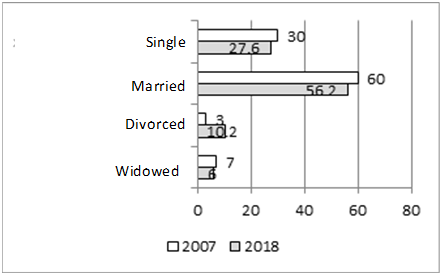
The total number of married people has decreased. Although the amount of married men is more than married women. Compared to 2007, the total share of divorced people among non-resident Khakass has increased (by 7.2%), and among women moving to the city, every fifth is divorced or widowed (19.6%). It can be assumed that women who are not burdened with family obligations are more flexible in movings.
It can also be noted about the changing overall concept of the modern Khakass family. First, the size of Khakass families migrating from a village to a city has significantly changed (Fig. 3). Secondly, the number of children in the families of indigenous people has decreased. Thirdly, the proportion of childless migrants has increased (25.6%).
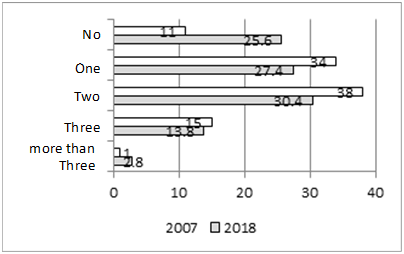
In addition, the national composition of families of rural migrants has changed due to inter-ethnic marriages. Moreover, according to obtained data, women are more inclined to inter-ethnic marriages compared to men. The proportion of mononational marriages among men is almost half (47.1%), and among women - about a third (36.9%).
A common idea is that a higher educational level contributes to a more successful adaptation of a migrant to a new community (Gordon, 1994). However, according to another opinion, the educational and qualification potential in the adaptation process “works” only if relevant social connections exist.
The educational level of the surveyed Khakass is generally average: most of the respondents have vocational education, although half (48.4%) have basic vocational education (at training school) or vocational education (at secondary technical school). Women have a slightly higher educational level than men: only one man in five (21.4%) has a higher vocational education and one woman in three (35.9%).
Comparing the educational and qualification level of the surveyed Khakass and Russians, it should be noted that the Khakass population has a higher educational level (Fig. 4). Only 16.2% of respondents among the Khakass have secondary education, almost a quarter (23.2%) is among Russians. At the same time, a higher educational level of the Khakass does not guarantee more favorable working conditions. The survey results showed that the Khakass migrants (compared to Russians) are more engaged in unskilled physical labor (14.6% and 10.8%, respectively). The prevailing category among Russians (21%) is the category of workers whose work is related to communication (service sector, trade). The Khakass, in comparison with Russians, are more represented in construction (11.6% and 6.6%, respectively) and education (10.6% and 9.4%, respectively).
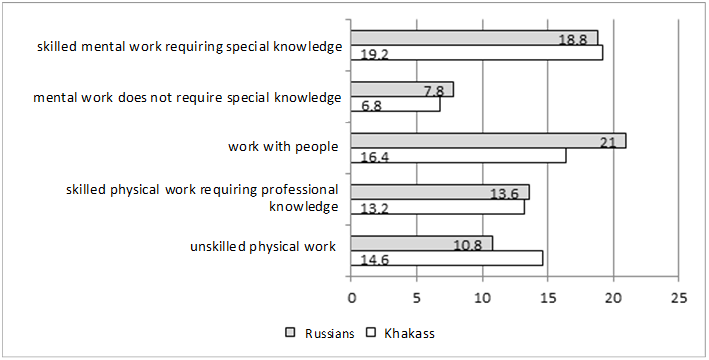
The “housing” issue remains the main difficulty for the Khakass to adapt in the city. According to Breslavskii (2011), the practice of temporary housing rentals is typical for rural residents in the city. Non-residents from rural areas had the opportunity to live in state or municipal housing 11 years ago (25% of surveyed among non-resident Khakass), but today such a possibility does not exist (Fig. 5).
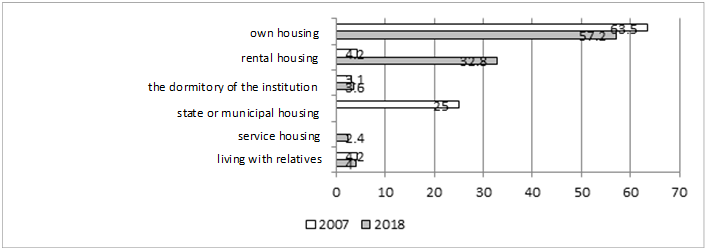
Therefore, rural Khakass are forced to live in rented accommodation, being unable to buy their own housing in the city. Compared to 2007, the share of people living in rented housing increased by almost 8 times and amounted to one third (32.8%) of the respondents surveyed.
At the same time, the general financial position of non-resident Khakass has improved (Fig. 6).

Firstly, the share of people having enough money only for food has decreased (by 8.9%); and secondly, the bulk of the population has increased - those who have enough money for food and basic necessities: more than half of those (56.3 %); thirdly, the number of people who have some savings allowing them to make large purchases has increased (for example, household appliances); fourthly, there are the Khakass who have the ability to deny themselves nothing.
Conclusion
The results of the study allow us to conclude that the rural migrant portrait of one of the Turkic peoples (Khakass) has changed. First, it is possible to speak about strengthening the trend of migration outflow from small villages with a population of less than 500 inhabitants, because half of the respondents come from small villages. Second, the social demographic characteristics of Khakass migrants have changed: there are more divorced people (especially women) and childless among non-residents. Third, the share of inter-ethnic families has increased, which indicates the strengthening of the assimilation processes of the titular ethnic group with the majority of the Russian population. Fourth, despite the improvement in the general financial position of the Khakass in the city, the problem of their own housing, on the contrary, has escalated. Fifth, it can be stated that, non-resident Khakass replenish the labor resources of the modern city, but the prevailing part of the respondents does not occupy prestigious jobs (service sector, trade), mainly related to physical rather than mental labor.
Acknowledgments
The reported study was funded by RFBR according to the research project (No. 18-39-00074 mol_a).
References
- Bilsborrow, R. E. (2011). Migration, population change, and the rural environment. ECSP Report, 8, 69–94.
- Breslavskii, A. S. (2011). Rural migrants in the post-Soviet Ulan-Ude space. Bulletin of Altai State University, 4-1(72), 22–25.
- Bychenko, Iu. G., & Shabanov, V. L. (2012). Modern migration of the rural population: features, directions, consequences. Bulletin of Saratov State Social Economic University, 2(41), 136–142.
- Gordon, L. A. (1994). Social adaptation in modern conditions. Sociological studies, 8–9, 3–15.
- Institute of Oriental Studies (2007). The Republic of Khakassia: Demography, language, political views (based on ethnosociological research materials, Informational and analytical bulletin, 6.
- Ishtiaque, A., & Ullah, Md. S. (2013). The Influence of Factors of Migration on the Migration Status of Rural-Urban Migrants in Dhaka, Bangladesh. Human Geographies, 07(02), 45–52.
- Khan, J., Hassan, T., & Shamshad (2011). Socio-Economic Causes of Rural to Urban Migration in India. Asia-Pacific Journal of Social Sciences, III(2), 138–158.
- Kliuev, A. V. (2015). Processes and levels of sociocultural adaptation of migrants in modern Russian society. Proceedings of St. Petersburg State Institute of Culture, 206, 345–351.
- Lushnikova, O. L. (2018). Social adaptation of rural migrants: theoretical and empirical aspects of the study. Discussion, 6(91), 48–59.
- Mosselson, A. (2010). “There is no difference between citizens and non-citizens anymore”: violent xenophobia, citizenship and the politics of belonging in postapartheid South Africa. Journal of Southern African Studies, 36(3), 641–55.
- Rosstat (2012). Results of 2010 All-Russian Population Census. National composition and language proficiency, citizenship. Moscow: IPC “Statistics of Russia”.
- Rosstat Abakan (2012). The population of the Republic of Khakassia for 2001-2011. Statistical collection. Abakan: Territorial body of the Federal State Statistics Service for the Republic of Khakassia.
- Shi, L. (2008). Rural migrant workers in China scenario, challenges and public policy. Geneva: ILO.
- Tinikova, E. E. (2018). Transformation of urban settlement in the national republics of Southern Siberia in the mid-20th and early 21st century. New Studies of Tuva, 4, 235–257. Retrieved from: https://nit.tuva.asia/nit/article/view/816 (accessed date: 13.02.2019.)
Copyright information

This work is licensed under a Creative Commons Attribution-NonCommercial-NoDerivatives 4.0 International License.
About this article
Publication Date
28 December 2019
Article Doi
eBook ISBN
978-1-80296-075-4
Publisher
Future Academy
Volume
76
Print ISBN (optional)
-
Edition Number
1st Edition
Pages
1-3763
Subjects
Sociolinguistics, linguistics, semantics, discourse analysis, science, technology, society
Cite this article as:
Lushnikova*, O. (2019). Social Demographic Portrait Of A Rural Migrant Of Turkic Peoples. In D. Karim-Sultanovich Bataev, S. Aidievich Gapurov, A. Dogievich Osmaev, V. Khumaidovich Akaev, L. Musaevna Idigova, M. Rukmanovich Ovhadov, A. Ruslanovich Salgiriev, & M. Muslamovna Betilmerzaeva (Eds.), Social and Cultural Transformations in the Context of Modern Globalism, vol 76. European Proceedings of Social and Behavioural Sciences (pp. 1997-2004). Future Academy. https://doi.org/10.15405/epsbs.2019.12.04.267
